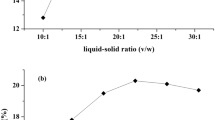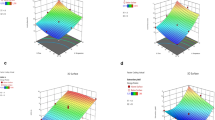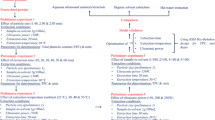Abstract
Satsuma mandarin, which is also known as Citrus unshiu, contains high amount of polyphenols and antioxidants. This study focused on the biowaste valorization of bioactive compounds used for food supplementary. For this purpose, ultrasonic extraction method was utilized. The antioxidant capacity and polyphenolic content of the Citrus unshiu extracts were determined. The number of experiments was reduced owing to the response surface methodology (RSM) and particle swarm optimization (PSO). Therefore, the extraction process has become more economical. In this study, according to the RSM, optimal conditions were determined as 90 min, 56% amplitude, and 50 °C. PSO suggested the optimal conditions as follows: 27 min, 50 amplitude, and 52 °C. For the performance metrics, RSM gave higher satisfactory results than PSO. For RSM, 8.953 GA/g-peel and 5.253 catechin/g-peel were obtained as total phenolics content (TPC) and total flavonoids content (TFC). For PSO, 6.977 GA/g-peel and 6.454 catechin/g-peel were obtained as phenolics and flavonoids. The highest R-values for TPC (0.9947) and TFC (0.9825) were obtained by RSM. The results proved that Citrus unshiu peel contains highly rich phenolic and high value-added bioactive compounds.









Similar content being viewed by others
References
FAO (2017) FAOSTAT: Food and Agriculture Organization of the United Nations
Satari B, Karimi K (2018) Citrus processing wastes: environmental impacts, recent advances, and future perspectives in total valorization. Resour Conserv Recycl 129:153–167
Bocco A, Cuvelier ME, Richard H, Berset C (1998) Antioxidant activity and phenolic composition of citrus peel and seed extracts. J Agric Food Chem 46(6):2123–2129
Chemat F, Khan MK (2011) Applications of ultrasound in food technology: processing, preservation and extraction. Ultrason Sonochem 18(4):813–835
Patist A, Bates D (2008) Ultrasonic innovations in the food industry: from the laboraty to commercial production. Innovative Food Sci Emerg Technol 9:147–154
Nassef AM, Rezk H, Abdelkareem MA, Alaswad A, Olabi A (2019) Application of fuzzy modelling and particle swarm optimization to enhance lipid extraction from microalgae. Sustain Energy Technol Assessments 35:73–79
Myers RH, Montgomery DC, Anderson-Cook CM (2016) Response surface methodology: process and product optimization using designed experiments. Wiley
Ilbay Z, Şahin S, Kırbaşlar Şİ (2013) Optimisation of ultrasound-assisted extraction of rosehip (Rosa canina L.) with response surface methodology. J Sci Food Agric 93(11):2804–2809
Sakanaka S, Tachibana Y, Okada Y (2005) Preparation and antioxidant properties of extracts of Japanese persimmon leaf tea (kakinoha-cha). Food Chem 89:569–575
McCulloch WWP (1943) A logical calculus of ideas immanent in nervous activity. Bull Math Biophys 5(4):115–133
Minsky M, Papert S (1969) Perceptrons: an introduction to computational geometry. MIT Press ISBN 978-0-262-63022-1
Kennedy J. and Eberhart R (1995) Particle swarm optimization. Proceedings of the IEEE International Conference on Neural Networks, 4, 1942-1948.
Ferreira SLC (2019) Chemometrics and statistics| Experimental Design.
Pan Y, Hao Y, Chu T, Li C, Zhang Z, Zhou Y (2010) Ultrasonic-assisted extraction, chemical characterization of polysaccharides from Yunzhi mushroom and its effect on osteoblast cells. Carbohydr Polym 80(3):922–926
Barfi B, Asghari A, Rajabi M, Barfi A, Saeidi I (2013) Simplified miniaturized ultrasound-assisted matrix solid phase dispersion extraction and high performance liquid chromatographic determination of seven flavonoids in citrus fruit juice and human fluid samples: hesperetin and naringenin as biomarkers. J Chromatogr A 1311:30–40
Xu Y, Pan S (2013) Effects of various factors of ultrasonic treatment on the extraction yield of all-trans-lycopene from red grapefruit (Citrus paradise Macf.). Ultrason Sonochem 20(4):1026–1032
Şahin S, İlbay Z, Kırbaşlar Şİ (2018) Pulsed ultrasound-assisted extraction of natural antioxidants from mandarin (Citrus deliciosa Tenore) leaves: experimental and modeling study. Chem Eng Commun 205(6):717–726
Oroian M, Ursachi F, Dranca F (2020) Influence of ultrasonic amplitude, temperature, time and solvent concentration on bioactive compounds extraction from propolis. Ultrason Sonochem 64:105021
Ciğeroğlu Z, Aras Ö, Pinto CA, Bayramoglu M, Kırbaşlar Şİ, Lorenzo JM, Şahin S (2018) Optimization of ultrasound-assisted extraction of phenolic compounds from grapefruit (Citrus paradisi Macf.) leaves via D-optimal design and artificial neural network design with categorical and quantitative variables. J Sci Food Agric 98(12):4584–4596
Kocherginsky N (2010) Temperature-driven mass, charge and heat transfer in terms of physicochemical potential and Einstein's mobility. Chem Eng Sci 65:4154–4159
Mustafa A, Turner C (2011) Pressurized liquid extraction as a green approach in food and herbal plants extraction: a review. Anal Chim Acta 703(1):8–18
Jovanović AA, Đorđević VB, Zdunić GM, Pljevljakušić DS, Šavikin KP, Gođevac DM, Bugarski BM (2017) Optimization of the extraction process of polyphenols from Thymus serpyllum L. herb using maceration, heat-and ultrasound-assisted techniques. Sep Purif Technol 179:369–380
Cheigh CI, Chung EY, Chung MS (2012) Enhanced extraction of flavanones hesperidin and narirutin from Citrus unshiu peel using subcritical water. J Food Eng 110(3):472–477
Ma Y, Ye X, Hao Y, Xu G, Xu G, Liu D (2008) Ultrasound-assisted extraction of hesperidin from Penggan (Citrus reticulata) peel. Ultrason Sonochem 15(3):227–232
Li BB, Smith B, Hossain MM (2006) Extraction of phenolics from citrus peels: I. Solvent extraction method. Sep Purif Technol 48(2):182–188
Funding
The authors gratefully acknowledge the financial support received from BAP (Project No: 802-29111) from the İstanbul University-Cerrahpaşa.
Author information
Authors and Affiliations
Corresponding author
Ethics declarations
Conflict of interest
The authors declare no competing interests.
Additional information
Publisher’s Note
Springer Nature remains neutral with regard to jurisdictional claims in published maps and institutional affiliations.
Rights and permissions
About this article
Cite this article
Poyraz, Ç., Küçükyıldız, G., Kırbaşlar, Ş. et al. Valorization of Citrus unshiu biowastes to value-added products: an optimization of ultrasound-assisted extraction method using response surface methodology and particle swarm optimization. Biomass Conv. Bioref. 13, 3719–3729 (2023). https://doi.org/10.1007/s13399-021-01329-9
Received:
Revised:
Accepted:
Published:
Issue Date:
DOI: https://doi.org/10.1007/s13399-021-01329-9




